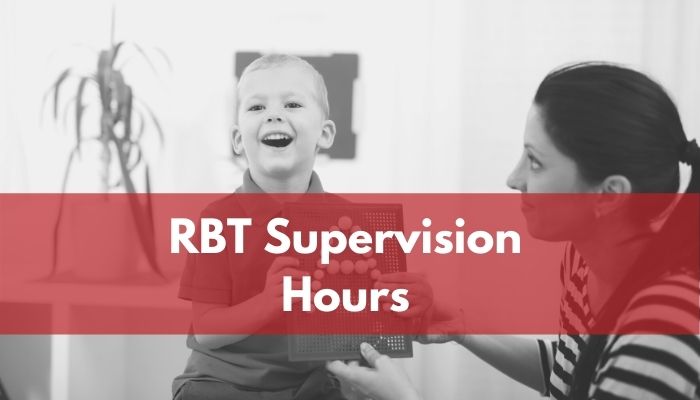
By Tania Duarte, M.S., BCBA
Training and supervising Registered Behavior Technicians (RBTs) is an essential part of a Board Certified Behavior Analyst’s (BCBAs) work. BCBAs are responsible for providing these valuable staff members with adequate training and guidance. We owe this to the RBTs, our clients, their families, and our profession.
Why Do We Train RBTs To Provide ABA Therapy?
BCBAs train RBTs to be able to conduct ABA sessions so we can provide a high-demand therapeutic intervention to a greater number of individuals. For example, let’s say you’re working as a BCBA and have an early intervention client who receives therapy 30 hours a week. Without RBTs, you would need to run those 30 hours of direct therapy a week yourself and find time for making program updates. This would likely result in you having no time to take on any additional clients, and therefore you would only be able to assist one individual at a time.
However, with a team of talented RBTs, you could utilize those same 30 hours of your week to assist 10 (30-hour-a-week) clients and still supervise 10% of each client’s sessions.

How Do We Maintain the Quality of Services Across Providers?
When supervising, it is essential to focus your observations not only on the client but also on the therapist. Ask yourself, is the therapist running the program correctly? How is your client responding to them? Is your client actively engaged? Do you need to update the programming? Is the therapist motivating your client with preferred reinforcers and utilizing them correctly?
You want to make sure you provide any feedback to the therapist to improve the quality of their sessions. When possible and appropriate, you may choose to utilize the Behavior Skills Training (BST) technique when training RBTs.
Steps to BST
- First, you give the instruction,
- Then, you demonstrate the skill so the individual can observe precisely how to perform that task.
- After, you will have the therapist perform the skill.
- Finally, you will provide feedback on their performance.
It Takes Time
So you provided feedback to the therapist; they should be good to go, right? No. Although you are likely to see improvement, it takes time, just like with anything. It is essential to keep track of the progress of not only your clients but also your RBTs.
Set goals for them and see how they do throughout sessions. Make sure to not only provide feedback on what to improve but always provide praise. The reason for this is you want to keep staff motivated.
Reinforce Your RBTs

Direct therapy can be extremely draining at times, so it is important to recognize staff achievements. If every time you supervise, the therapist only hears corrective feedback from you and nothing positive, your presence and supervision won’t be received well. Just imagine how it would feel if all you heard at work was negative feedback. You might consider quitting your job and maybe even the field. Unfortunately, there is a shortage of ABA practitioners, and companies are struggling to keep quality therapists. Value your staff and put time and energy into helping them grow professionally.
Goal Setting
Throughout your observations, supervising BCBA’s should get a good idea of each therapist’s current strengths and weaknesses. You’ll want to look at what they are currently struggling with and prioritize some skills to focus on for improvement. Ask yourself what skills are most vital to the therapist’s and client’s success? If you do not see improvement, what can you change? Should you try a different feedback strategy? It’s also vital to document your observation, feedback and adjust goals as needed. An OBM software solution like Pinnacle can streamline this process for you and your practice.
Data is Not Just For Clients

How do we ensure that RBTs are performing well and not falling through the cracks? Just like you take data on your clients’ progress, you should take data on your technicians’ progress too. If you do not see improvement, what can you change as a supervisor? Should you try a different feedback strategy?
With tools like Pinnacle’s OBM Supervision Software, you can score staff performance with a variety of data measurements such as yes/no checklists and Likert rating scales. You can also track the progress of BACB ® task list items to ensure your performer’s preparedness for the RBT ®, BCaBA ®, BCBA ®, or BCBA-DTM certification exams. Additionally, you can keep your supervision sessions organized and well-documented while keeping the data centralized. Want to learn more about ABA professional supervision and Pinnacle software? Check out our free trial below.

Tania Duarte, M.S., BCBA
Tania Duarte received her M.S. in Applied Behavior Analysis from Florida State University. She has over ten years of clinical experience working with individuals with disabilities in various settings, including schools, homes, clinics, and community settings. Additionally, she has worked with DataFinch's Customer Experience Team, assisting ABA practitioners with their data collection software needs. Tania currently serves as the eLearning M.A. Program Coordinator at ABA Technologies and works with students pursuing their masters in ABA at the Florida Institute of Technology.
Learn How Pinnacle Automates ABA Supervision
This post is for informational purposes only and is not meant to be used in lieu of practitioners’ own due diligence, state and federal regulations, and funders’ policies.
